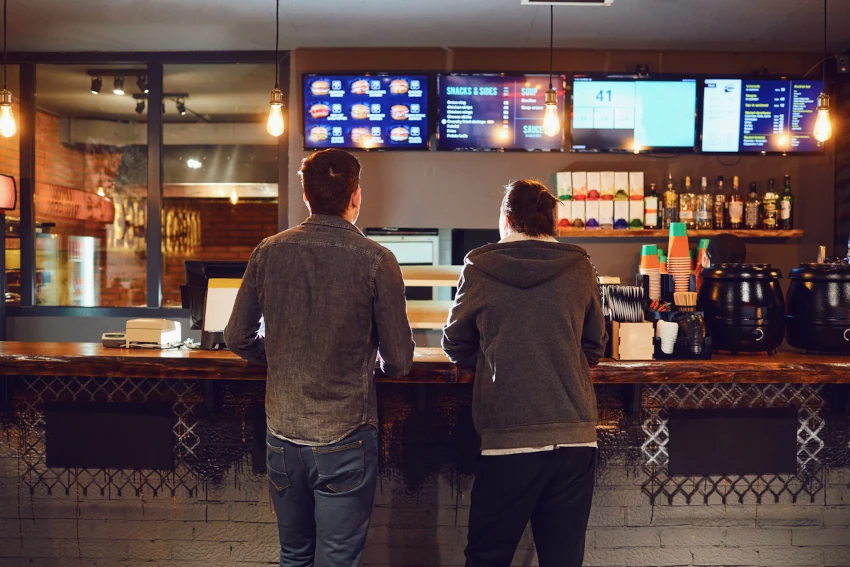How Fast-Food Franchises Can Benefit From Digital Signage
Around 37% of adults in the United States consume fast foods, leading to significant growth in the fast food industry. Consumers opt for fast foods as they save time through quick orders and purchases. Quality and prompt service delivery are essential to maintain a competitive edge in the American fast-food industry.
Therefore, leading fast-food franchises like McDonald’s have adopted the use of digital signage in their operations to meet these standards. Here are reasons you should also integrate digital signage into your fast food franchise.
1. Data Analytics
Data collection and analysis are crucial factors in marketing. The data you collect helps you in audience targeting and product development. With digital kiosks, you can easily collect data for analytics.
For instance, the digital kiosks at McDonald’s incorporate a payment system. This way, the franchise can know the preferences of a particular consumer, frequently ordered items, and common product combinations.
Therefore, the franchise can offer product combination suggestions and know which products they can promote through advertising. Additionally, the data collected will help them curate personalized menus for their clients.
2. Shorter Queues
Long queues at a fast-food restaurant can be due to slow service delivery or indecisive consumers. Clients who haven’t learned what is on the menu take longer to decide what they will have. You need only a handful of such customers to cause a hold-up on the line.
Consequently, to solve this problem, quick service restaurants (QSR) have adopted the use of digital menu boards. Strategically placed at the register or the entrance of quick service restaurants, digital menu boards display all delicacies available.

Therefore, when customers are at the counter, they already know what they want to order. What’s more, some fast food chains like Dairy Queen have self-ordering digital kiosks, which help reduce delays at the counter.
Additionally, others like Domino and Popeyes have a digital pick-up system. Through this system, a consumer who made an order online doesn’t have to come into the store and queue. They alert the restaurant of the time they’ll pick up the order. So, once in the restaurant, a digital screen indicates their order is ready, and they can bypass the line.
3. Reduce Perceived Customer Wait Time
If you cannot eliminate queues in your stores, digital signage helps reduce the perceived wait time. When a client stands in the waiting line, all they can think of is how long it takes till it’s their turn.
However, you can set aside a screen for consumer entertainment. Here, you can showcase some exciting facts about the ingredients used in some dishes. Or, like Baskin Robbins, you can have a heritage wall that displays your restaurant’s franchise success story.
Entertaining or informational video content captures your audience’s attention and makes them happy. Games installed on the interactive digital kiosks will also keep consumers occupied while they wait for their orders. This way, the client won’t be too aware of the time spent in the waiting line.
4. Brand Consistency
Generally, the franchise agreement requires business owners to maintain the franchisor’s business model. Additionally, they need the entrepreneurs to uphold the brand image that the franchisor has built over time to maintain the brand’s credibility.
Digital signage will help ensure that the restaurant chain maintains the brand’s appearance despite having different owners. For instance, through a centralized signage server, Wendy’s airs similar family-friendly channels across its stores.
As a result, you easily maintain similar logos, brand colors, and menus across the franchise. If you use different servers, you’ll need to share the color palette and logo with the franchise owners.
Consequently, the red, black, and white KFC colors are similar regardless of the state where you consume your fried chicken. Digital signage will aid brand recognition and consistency regardless of location and franchise owner.
5. Increase Revenue
The initial investment of a restaurant franchise is usually high, even for the lowest fast-food franchise opportunities available. This initial investment includes the net worth per unit or for multi-units; and the value of liquid assets that makes you eligible for a franchise. You’ll also pay a royalty fee to the franchisor.
Therefore, an increase in your profit for a new restaurant will help you recover the startup cost. Digital signage helps you increase sales and cater to the franchise cost. Menu board displays can increase sales through product promotion. In fact, a Culver franchise owner in Palatine reported an increase in sales five times more than usual due to digital menu boards.

You can also use point-of-sale screens for product promotion at the counter. For instance, Pizza Hut uses point-of-sale screens to display special offers, limited offers, and popular combinations. This way, it’s easier to upsell and introduce new products to the consumer at the cash register.
Actually, digital signs in stores are responsible for the increase in impulse purchases as they influence buyer decisions. Therefore, you can increase your profit margin through digital signage and cover any franchise fee.
6. Easy Menu Changeover
Traditionally restaurants used menu cards and posters to display the day’s specials. Restaurants had to take down posters, print them and display them again in case of any updates. However, with digital signage, you can show your menu items on digital menu boards.
What’s more, you can change the menu according to different times and seasons. In the morning, you’ll find displays of Dunkin’s breakfast menus with coffee and donuts. At lunch on hot days, the digital menu boards change their menus to keto drinks, iced coffee, and burgers.
You can automate the changing of menu items on your digital screens. As a result, you can assign your staff to more person-dependent tasks.
7. Display Dynamic and Diverse Content
Technology has made communication easier as businesses can receive immediate consumer feedback. Besides, the company can efficiently distribute information to its clients. Digital signage is a very effective communication tool for fast-casual restaurants.
For instance, you can use some of your digital screens for product awareness and, like Burger King, display job openings. For instance, Papa John’s uses their digital screens to display their partnerships with local sports teams and for social media campaigns. Such content ensures they remain connected with customers at a personal level.
Moreover, as consumers become more health-conscious, fast food chains like Wendy’s are also displaying the nutritional content of their products. Besides, you can display artwork that leaves your clients salivating and enhances the ambiance of your full-service restaurants.
Additionally, the screens at Dairy Queen keep you entertained as you enjoy your favorite ice cream or munch on your favorite hotdogs and hamburgers. You’ll notice that some screens display customer reviews and photos, employee stories, and upcoming local events.
8. Offer Personalized and Enhanced Customer Experience
Consumers are one of the essential stakeholders for any business. Indeed, since 80% of consumers claim consumer experience is as crucial as product quality, the success of any business depends on the customer experience they offer.
Poor customer service decreases customer satisfaction and reduces the possibility of repeat purchases. Digital signage enhances customer experience through fast service delivery and personalized services.
For example, Chick-Fil-A introduced screens with cameras at their drive-thrus to enhance customer experience. Therefore, despite COVID-19 restrictions, consumers could still interact with the employees. Also, Checkers and Rally’s introduced AI voice ordering at their drive-in to offer their clients a faster and more efficient experience.
At Taco Bell, interactive digital kiosks make it easier for clients to choose between tacos, burritos, and other Mexican delicacies. The digital kiosks allow customers to self-order. Besides, other digital kiosks address consumers by name and offer a curated menu based on previous customer orders. These interactions enhance the consumer experience by reducing delays.
Install Digital Signage in Your Restaurant and Enjoy the Benefits
Technology is now a fundamental part of business operations that is here to stay. Therefore, integrating digital signage into your franchise business will give you a competitive edge in the restaurant industry.
Digital signage ensures smooth operations on your premises, which increases customer satisfaction. Now that you know the benefits of digital signage for QSRs, it’s time you invest in digital signage. You, too, can profit from using this cutting-edge technology.


